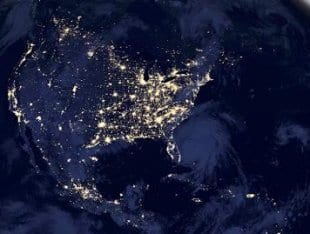In the wake of Hurricane Sandy, states in the Northeast U.S. have been putting the weight of government policy and budgets behind microgrids, self-sustaining islands of electric power to keep hospitals, emergency responders and critical services running in the midst of broader grid blackouts.
That’s an important goal for grid resiliency, and one that could play a role beyond blackouts. After all, networked aggregations of distributed green power, energy storage, backup generation and demand-side management are convenient building blocks when developing a green-energy-integrated grid.
But that’s harder than it sounds. Creating the economic and regulatory structures that allow public-private partnerships to operate microgrids as islands in a sea of utility controlled power infrastructure is challenging enough. Adding intermittent green energy resources to that mix — and finding ways for them to serve functions and make money during the vast majority of the time the grid isn’t blacked out — just adds to the challenge.
Take the examples of two significant microgrid programs in Connecticut and Massachusetts, both of which opened up multi-million-dollar RFPs last month. In Connecticut, lawmakers and utilities are further along than those in any other state in terms of putting real money into viable on-the-ground projects. They’ve currently doled out $18 million and are now accepting applications for $15 million more. But the program’s emphasis on existing fossil-fuel-fired infrastructure hasn’t given much room for clean energy resources in its first round.
In Massachusetts, by contrast, the program that is now accepting applications gets its $40 million from a renewable energy fund, and comes with an emphasis on clean technologies, including solar and wind power, energy storage, and smart building energy management systems. It’s also working on finding ways for microgrids to provide grid support services, with an eye on broader energy market participation down the road.
States including New York, New Jersey and Maryland are seeking microgrid projects for their own multi-million-dollar grid resiliency programs, making the experience of early-starter states like Connecticut useful for all comers. But the emphasis on green energy for Massachusetts may be better suited for the kinds of advanced functions we’re looking at on the grid edge. Here’s a breakdown of the two programs, starting with the one that’s made the most progress to date.
Connecticut’s reliability-first, public-private partnership model
Connecticut’s microgrid program was passed into law in 2012, one year after Hurricane Irene knocked out power to some 8 million state residents. In its first round of funding, it gave out $18 million to nine different projects, worth a combined 15 megawatts of distributed generation capacity, meant to keep hospitals, fire stations and community centers running during severe storms.
Last week, Wesleyan University started up the first of these projects, a 3.2-megawatt combined heat and power (CHP) system to power its athletic center during emergencies. Projects in Bridgeport, Fairfield, Groton, Hartford, Middletown, Storrs, Windham and Woodbridge should start coming online over course of summer, said Alex Kragie, deputy chief of staff at the state Department of Energy and Environmental Protection (DEEP).
That includes a big project in Hartford that’s reshaping utility infrastructure by permitting cities and universities to link building power systems across utility rights-of-way (i.e., roads), he noted.
Last week, DEEP issued an RFP for the second, $15 million round of projects, capped at awards of $3 million apiece (PDF). The department will start selecting projects this summer and expects the first awards to be announced by year’s end, said Kragie. Governor Dannel Malloy has proposed to add $30 million more in program funding to the state’s upcoming two-year budget, which could open up future rounds.
“From a big-picture policy perspective, the microgrid program is another way of us tackling the governor’s mandate of cheaper, cleaner reliable electricity,” Kragie said. “At the same time, it’s about ensuring this level of reliability, so that if the larger grid goes down, these microgrids pop up, and these facilities can serve their intended function,” he said, which is “increasing safety and quality of life for our residents.”
Natural gas is a reliable backup energy source in hurricanes, since underground pipes are far less susceptible to wind and flooding damage than are overhead power lines. Wesleyan’s 3.2 megawatts can light and heat the university’s athletic center in order to shelter up to 48,000 residents, as well as to serve as a Federal Emergency Management Agency distribution center. That’s something no amount of solar or wind power could do reliably for days at a time, even combined with energy storage.
Connecticut’s program also doesn’t give out any money to purchase generation equipment; it only funds the design, construction and operation of the physical and IT assets needed to link generation units together. Big, pre-existing university CHP systems and municipal steam-heat systems are the cheapest, most reliable resource to start with in that context.
That’s limited non-traditional generation to a tiny sliver of the state’s total first-round project energy mix. The University of Connecticut includes one 400-kilowatt fuel cell and 6.6 kilowatts of solar PV, and the town of Windham is adding 200 kilowatts of solar PV and a 200 kilowatt-hour battery to help keep two schools powered in a blackout. Add in a few sub-10-kilowatt solar PV systems, and that’s about it.
But given the state’s goals, that makes sense. The newly opened RFP sets certain review criteria governing how it’s going to pick winning proposals, and 45 percent of it is based on “financial, managerial and operational capability,” including proposed projects’ ability to land financing on a cost-per-kilowatt basis. Technical merits account for 25 percent, while combining public and private facilities is worth 20 percent. Environmental benefits, or the “use of clean, renewable, and reliable generation resources in the project,” are only worth 10 percent.
Will this next round have more clean energy in the mix? That depends on what’s in the proposals, Kragie said. At the same time, the state’s Green Bank has formed a microgrids team to look at low-cost clean power financing options, he added. It’s also seeking to open the next round of projects to thestate’s reverse auction program for solar, wind and fuel cell projects, he said. That program required utilities to purchase a combined 31 megawatts of projects (87 MW of solar, 10 MW of fuel cells) in a first auction of zero- and low-emissions energy credits in 2012.
As for grid interconnection, green resources are allowed access to the state’s existing net metering laws for so-called Class 1 resources, as well as smaller amounts in special riders for other types of natural gas generators. Beyond that, “We’re trying to work with each applicant on a case-by-case basis,” said Kragie. “Our utilities have, after some hesitation, been fantastic in being flexible and being great partners in making sure that each site’s specific needs can be addressed.”
That’s not a simple matter, considering the uncertainty around how utilities will get along with customers that can generate their own power.
Massachusetts: The green-funded community nanogrid model
In January, Massachusetts Governor Deval Patrick announced a $50 million climate resiliency project, $40 million of which was aimed at a municipal resilience grant program funded by the commonwealth’s Department of Energy Resources. That money comes directly from the Renewable Portfolio Standard Alternative Compliance Payments — penalties paid by retail electricity providers when they fail to meet the state’s renewable and alternative energy credit quotas.
“By legislation, that requires that the use of clean energy technology,” Amy McGuire, who heads up the department’s Community Clean Energy Resiliency Initiative, said in an interview last week. “That means renewables, of course — and it can also mean natural gas CHP, because of [that technology’s] efficiency. It also allows energy storage and islanding technologies…in case the grid goes down.”
Massachusetts’ Department of Energy Resources (DOER) opened a request for qualifications and quotation last month that lays out its clean emphasis in more detail (PDF). The overriding requirement for projects is that they provide power “where loss of electrical service would result in disruption of a critical public safety life sustaining function” — in other words, they’ve got to stay on, no matter what.
That involves the ability for buildings to keep themselves lit and warm, and not just in the context of a microgrid, McGuire said. Projects could also include “nanogrids,” or “building resilience into buildings, rather than depending on broader network assistance,” she said. “We’re confident that at least a few of these will come out of this process.”
Unlike its neighbor to the south, Massachusetts will fund clean generation and energy storage costs, as long as they aren’t already getting money from other incentives, McGuire said. Those include fuel cells and CHP, solar and wind power, electrical or thermal energy storage, and energy management systems for load-shedding and critical load isolation for the demand side of the equation.
“We’re looking at where we might have solar systems in place and adding storage, or existing CHP systems that might need some retrofits to island and black-start [in order to] operate in that resiliency mode,” she said. “Black start” refers to the special setup for generators that can help the grid get up and running after a blackout, a kind of grid interactivity that could lend itself to ancillary services like frequency regulation further down the line.
“Providing services to the ‘macro-grid,’ these systems could easily serve as peaking power resources for demand response, and grid stability services,” she said. The $40 million project team is working with the Department of Public Utilities, which has a broader smart metering and smart grid programunderway, to see how the two efforts could align, she said.
GTM Research’s soon to be released report, North American Microgrids 2014: The Evolution of Localized Energy Optimization, addresses how campus co-generation and building emergency backup systems are starting to grow into renewable energy, energy storage and demand-side management hybrids. The big question is how to find ways to put that expensive equipment and expertise to use, in order to make money and cut costs during the 99 percent of the time the system is connected to, not islanded from, the grid.
Source: GreenTech Media. Reproduced with permission.











